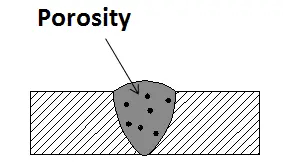What is Porosity in Welding: Finest Practices for Avoiding Porous Welds
Untangling the Enigma of Porosity in Welding: Tips for Lessening Flaws and Optimizing Quality
In the elaborate globe of welding, porosity continues to be a relentless challenge that can considerably influence the top quality and stability of welded joints. As we delve into the depths of porosity in welding, revealing the keys to its avoidance and control will be paramount for professionals seeking to understand the art of premium weldments.
Recognizing Porosity in Welding
Porosity in welding, an usual problem come across by welders, describes the visibility of gas pockets or spaces in the bonded material, which can compromise the honesty and quality of the weld. These gas pockets are commonly caught during the welding procedure due to different variables such as improper protecting gas, infected base materials, or wrong welding criteria. The formation of porosity can damage the weld, making it vulnerable to breaking and deterioration, inevitably resulting in structural failures.
By identifying the importance of maintaining appropriate gas shielding, ensuring the tidiness of base materials, and enhancing welding settings, welders can dramatically minimize the chance of porosity development. Overall, a detailed understanding of porosity in welding is important for welders to create high-grade and resilient welds.

Typical Reasons For Porosity
When checking welding procedures for possible top quality concerns, understanding the common causes of porosity is important for preserving weld stability and stopping architectural failures. Porosity, identified by the visibility of dental caries or gaps in the weld steel, can dramatically endanger the mechanical residential or commercial properties of a bonded joint.
An additional widespread root cause of porosity is the visibility of dampness and pollutants externally of the base metal or filler material. When welding products are not appropriately cleaned up or are subjected to high levels of humidity, the evaporation of these impurities throughout welding can produce voids within the weld grain. Additionally, welding at improper criteria, such as exceedingly high travel speeds or currents, can create too much turbulence in the weld pool, capturing gases and creating porosity. By addressing these usual reasons via appropriate gas shielding, product prep work, and adherence to ideal welding specifications, welders can reduce porosity and improve the quality of their welds.
Techniques for Porosity Prevention
Applying efficient safety nets is essential in reducing the incident of porosity in welding procedures. One technique for porosity prevention is making sure proper cleaning of the base steel before welding. Pollutants such as oil, grease, rust, and paint can bring about porosity, so detailed cleansing making use of proper solvents or mechanical approaches is vital.

Using premium filler products and securing gases that are ideal for the base steel and welding procedure can significantly dig this reduce the risk of porosity. Furthermore, maintaining appropriate welding criteria, such as voltage, existing, take a trip speed, and gas flow rate, is essential for porosity avoidance.
In addition, using correct welding strategies, such as keeping a consistent travel speed, electrode angle, and arc size, can assist avoid porosity (What is Porosity). Sufficient training of welders to ensure they adhere to best practices and quality assurance treatments is additionally crucial in decreasing porosity issues in welding

Ideal Practices for Quality Welds
One key practice is maintaining correct sanitation in the welding location. Completely cleaning the work surface and surrounding location prior to welding can help mitigate these concerns.
An additional finest practice is to carefully choose the appropriate welding criteria for the particular products being joined. This consists of establishing the correct voltage, present, take a trip my blog rate, and shielding gas circulation rate. Correct parameter selection makes certain optimum weld infiltration, combination, and overall high quality. Making use of top quality welding consumables, such as electrodes and filler steels, can dramatically impact the last weld top quality. Purchasing costs consumables can lead to more powerful, a lot more durable welds with less defects. By following these best practices, welders can constantly generate high-quality welds that fulfill market requirements and exceed client assumptions.
Relevance of Porosity Control
Porosity control plays an essential role in guaranteeing the stability and high quality of welding joints. Porosity, defined by the existence of dental caries or spaces within the weld steel, can substantially jeopardize the mechanical buildings and architectural honesty of the weld. Too much porosity deteriorates the weld, making it a lot more prone to cracking, corrosion, and overall failing under functional tons.
Effective porosity control is necessary for maintaining the wanted mechanical homes, such as stamina, ductility, and durability, of the welded joint. What is Porosity. By reducing porosity, welders can improve the overall top quality and integrity of the weld, making certain that it fulfills the performance requirements of the intended application
In addition, porosity control is crucial for achieving the preferred visual appearance of the weld. Too much porosity not only damages the weld but likewise detracts from its aesthetic allure, which can be crucial in markets where aesthetic appeals are very important. Proper porosity control techniques, such as making use of the proper shielding gas, managing the welding specifications, and making certain correct tidiness of the base products, are necessary for generating high-quality welds with minimal issues.

Final Thought
To conclude, porosity in welding is a typical defect that can endanger the quality of the read what he said weld. By comprehending the root causes of porosity and implementing appropriate prevention methods, welders can lessen flaws and accomplish better welds. It is important to control porosity in welding to ensure the stability and strength of the end product. Applying best practices for porosity control is critical for achieving ideal welding outcomes.